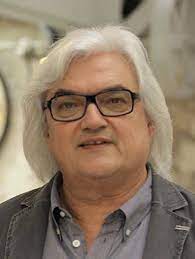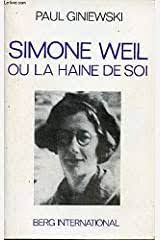Was Simone Weil an anti-Semite?
Eric SpringstedFrom time to time Attention will provide profiles of books or articles published abroad in non-English languages. The piece below by Dr. Eric Springsted is the first of such profiles. Our hope is to alert our readers to some of the important work being done on Weil by authors in non-English speaking countries and to thereby encourage and enhance a more global dialogue. — rklc
Robert Chenavier, Simone Weil, une Juive antisémite? Éteindre les Polémiques. [Simone Weil, an Anti-Semitic Jew? Extinguishing the Polemics] Paris: Gallimard, 2021. 226 pp. (e-book available.)
It is well known that Simone Weil’s relation to Judaism is not an easy one. It is also highly complicated. On the one hand, there are her scathing comments on the Old Testament. On the other, there are her far less frequent, but now breathtaking, comments and attitudes towards Judaism and Jews in her day. The latter has spawned a body of literature that has attacked Weil mercilessly as someone who is fully anti-Semitic, and, in some cases, “worse than Hitler,” and above all as a self-hating Jew.

Robert Chenavier has performed a highly valuable service in this important book He does not undertake to discuss Weil’s comments on the Old Testament, except as needed. Rather, his task is simply, and this is task enough, to confront the issue of whether or not she was anti-Semitic. In doing so he is not trying to close the conversation, but, as his subtitle suggests, he wants to extinguish the polemics. Once that has been accomplished, a genuine and open discussion of just what Weil’s relation to Judaism means within her thinking can take place. The polemical charges against her have prevented this, as they have largely been challenges to her readers to not read Weil at all because of her moral and psychological diseases.
The historical evidence
Chenavier undertakes his task in three parts. Part I lays out the historical evidence and all the texts that are at issue, seeking context for them, and situating them within Weil’s own life as well as the historical situation in which they were written. He finds that when Weil is charged two problems surface: first, later standards are frequently laid on what she wrote at an earlier time, and second, often such charges are laid on her selectively. What she said and did or wrote was not always exceptional. Sometimes, as in the case of her reporting from Germany in 1932-1933, she did underestimate what was going on with the Jews. But she wasn’t the only one.

What is of particular importance, though, is Chenavier’s reminding his reader that as far as Weil’s relation to Judaism was concerned, she simply did not identify with it at all. There is no doubt that she knew she was Jewish in origin, she knew she was vulnerable and subject to persecution, but it was something that, as she wrote to a former student, Huguette Baur, similarly situated, was absurd. If she has been charged with failing to sympathize and suffer with the Jews, when she was so willing to do so with other groups, well, that is right. But that sort of choice is not unusual for anybody. We are all willing to put ourselves on the line for certain things. But if we are made to suffer for what we regard as accidental, something that we think has no particular reality for us, the meaninglessness of chance starts to loom over us. It, in fact, can distract us from our giving ourselves to what we think is important. Weil was willing to accept what was coming, and had no intention of denying that it was going to be directed to her, but it was not part of her vocation. In that sense it was absurd.
The anti-Semitism charge

In the second, and lengthiest part of the book, Chenavier then takes on in chronological sequence, the most visible and most polemical proponents of the anti-Semitism charge. He begins with Marc Kac (a doctor with the Free French who examined Weil in 1943) and continues with the infamous Paul Giniewski (Simone Wei ou la haine de soi 1977. [Simone Wei or Self-Hatred]). Giniewski’s virulent attacks (quite in line with his general personality and scholarship) have been the most apparent touchstones for much of the later polemics. His was the book) that started it all.
The list of Weil critics is extensive, and not confined to France, as it includes George Steiner’s criticisms in his 1992 New Yorker article (March 2, pp. 86-91). Steiner’s article was a review of Thomas Nevin’s hatchet job, Simone Weil: Portrait of a Self-Exiled Jew (1991). Chenavier deals with each individually, but does find some common characteristics of all of them:
- the claim that there is “a Jewish point of view” and that the author is uniquely able to express it, even though more than one Jew has actually seen things differently about Weil, valuing much of what she has to say, and yet each one of these writers has still been able to be critical;
- the claim that there is something like a Jewish essence that one cannot possibly walk away from, even though this is never defined by anybody, nor are the thorny issues of such essentialism ever dealt with by those who propose it. But because of this essence, any attempt, these critics argue, to walk away from one’s Jewish origins is a form of killing Jews, and people like Weil who do so are worse than Hitler; and
- generally, too, these attacks have used selective uncontextualized citations from Weil; they are also anachronistic and use speculative medical and psychiatric diagnoses to make their case. This, it should be noted, is true even in the case of Francis Kaplan, who sought to write a serious book on anti-Semitism (La Passion anti-semite habillée par ses idéologues [The anti-Semitic Passion], 2011) with careful distinctions between opinions that were “anti-Hebraic” and those that were anti-Semitic, ones born out of a passionate obsession and hatred. While Weil would certainly seem to fit the first case, Kaplan surprisingly and without reservations puts her in the second category, even while letting others such as Renan off the hook for writing and thinking the same sort of things that she did.
The Philosophical Issues
The third section deals with the philosophical issues of Weil’s choice, and works closely with one particular text. While with the Free French in London, it fell to Weil to write comments on a report that came from the OCM (Organization Civile et Militaire) a resistance group. The report dealt with the “Jewish question,” which was in this case a question of how to deal with unassimilated Jews (and foreigners) with respect to national unity. Weil’s own approach to the question in her comments on the report was to let them be assimilated – she thought that the spiritual renewal of the country that she envisioned in The Need for Roots should be persuasive over time. But she also made comments that show a lot less patience, and allow for harsher and quicker solutions. Her comments are a problem, and not even consistent, as Chenavier points out. This is not to excuse her, but to raise the following philosophical questions:
- “What does it mean to do or recommend something like this?”
- “Can one divorce oneself from one’s situation, as a freely, unattached mind?”
- “Is this within the realm of freedom of opinion that is necessary for thought?”
These are issues for discussion. But that discussion, which needs to happen, cannot happen until the polemics with their hyperbolic charges have been extinguished.
Conclusion
In his conclusion, Chenavier astutely observes the unique historical situation of Weil’s generation. Between Dreyfus and the discovery of the death camps in 1945, Jews in France could easily think themselves assimilated because they were, and that Jewish identity was not something that they had to think about. That was the situation with Weil’s family. That is simply an historical fact. It accounts for Weil’s choice of identity and her attitudes about it. But, he notes, it resulted also in a whole generation of Jews who never engaged in Jewish questions that Hitler forced on them, often disastrously. The disaster is that they didn’t think about it beforehand and so the community was unprepared. Weil knew of Jewish suffering, and knew that she could suffer because of her origins. But the Jews were not her focus. That doesn’t mean that she hated them, or hated her origins, or was unfeeling about Jewish suffering. What that all then does mean is something that deserves further discussion.

This is an extremely valuable book for anyone who works on Weil. It offers a deep sense of her choices, and of the issues of self-identity. It is historically wise and balanced, and heavily detailed. It is, finally, a good guide through these issues. I cannot recommend it highly enough. No Weil scholar for many years will be able to say anything of substance on these issues if she or he does not know this book. One hopes that it will find a translator.
Eric O. Springsted is the author, most recently, of Simone Weil for the Twenty-First Century, University of Notre Dame Press (2021). He is also on Attention’s advisory board.
Selected Sources {in English}
— Palle Yourgrau, Simone Weil, London: Reaktion Books (2014), 117-135.
______, “Was Simone Weil a Jew?,” Partisan Review, vol. 68, no. 4, (Fall 2001): 629-641.
— Robert Coles, Simone Weil: A Modern Pilgrimage, New York: Addison-Wesley (1987), 43-62.
— Francine Du Plessix Gray, Simone Weil, New York: Viking/Penguin (2002), 145-149.
— Robert Boyers, intro., George Steiner at the New Yorker: Essays, New York: New Directions Publishing (2009), 219-229.
— George Steiner, “Saint Simone: The Jewish Bases of Simone Weil’s Via Negativa to the Philosophic Peaks,” Times Literary Supplement (June 4, 1993), 3-4.
— Sylvie Courtine-Denamy’s Three Women in Dark Times: Edith Stein, Hannah Arendt, Some Weil — or Amor fati, amor mundi, G.M. Goshgarian trans. (Cornell University Press, 2000), 3, 127-128, 202-205.
6 Recommendations
